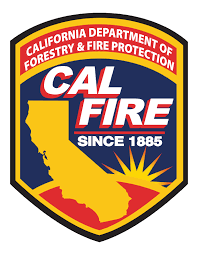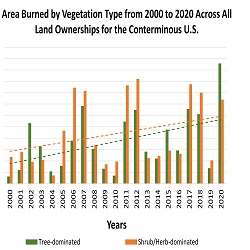Fire Regimes
Symposium webpage.
This event will held at Cal-poly San Luis Obsipo, and it will be the same energizing blend of science, management, and conservation as our prior symposia.
This year’s session topics include:
- Balancing fire risk and environmental impacts
- Effects of changing fire regimes in chaparral
- Strategies & goals for stewarding chaparral: Case-studies from the field
- Chaparral restoration: approaches and lessons learned
Register here by April 10th, 2024. Please do not register until you are sure you are able to attend. If you need to cancel your registration, please be sure to do so immediately so someone else may register for your spot.
Webinar registration.
We conducted a natural range of variation (NRV) assessment of montane conifer forests in the Transverse and Peninsular Mountain Ranges of southern California. Using current and historical literature and data, we present a quantitative analysis of forest function, structure, composition, and ecological processes prior to Euro-American settlement and compare those elements to the forests of today. We highlight how grazing, logging and fire suppression have altered natural fire regimes and examine how departure from NRV conditions may inform forest management in the era of climate change.
View article.
Frequent and catastrophic wildfires are an increasing threat to the ecological and economic stability of Great Basin rangelands, specifically sagebrush rangelands at risk of exotic annual grass invasion (Crist et al. this issue). Historically, fires were a periodic disturbance in these communities that shifted dominance from woody vegetation to herbaceous vegetation (Wright and Bailey 1982; Miller and Rose 1999) and likely promoted diversity (Davies and Bates 2020). Alterations in fuel characteristics with exotic plant invasions and increased anthropogenic ignitions have greatly elevated the likelihood of wildfires in many of these rangelands (Balch et al. 2013; Fusco et al. 2022). However, other rangelands are experiencing decreased fire frequency, largely caused by reduced fine fuels from anthropogenic-induced alterations to plant community composition or land use. Though longer fire return intervals can also be problematic because they cause undesirable plant community compositional shifts and decreased heterogeneity in some rangelands, this special issue is focused on the problem of more frequent and catastrophic wildfires as this is a more pressing concern in terms of the rate of undesirable ecosystem change and risk to property and life.
View synthesis.
Increases in fire activity and changes in fire regimes have been documented in recent decades across the western United States. Climate change is expected to continue to exacerbate impacts to forested ecosystems by increasing the frequency, size, and severity of wildfires across the western United States (US). Warming temperatures and shifting precipitation patterns are altering western landscapes and making them more susceptible to high-severity fire. Increases in large patches of high-severity fire can result in significant impacts to landscape processes and ecosystem function and changes to vegetation structure and composition. In this synthesis, we examine the predicted climatic influence on fire regimes and discuss the impacts on fire severity, vegetation dynamics, and the interactions between fire, vegetation, and climate. We describe predicted changes, impacts, and risks related to fire with climate change and discuss how management options may mitigate some impacts of predicted fire severity, and moderate some impacts to forests, carbon, and vegetation changes post fire.
View article.
Pyrodiversity may affect biodiversity by diversifying available ecological niches, stabilizing community networks and/or supporting diverse species pools available for post-fire colonization. Further, pyrodiversity’s effects on biodiversity vary across different spatial, temporal and organismal scales depending on the mobility and other life history traits of the organisms in question and
may be mediated by regional eco-evolutionary factors such as historical fire regimes. Developing a generalizable understanding of pyrodiversity effects on biodiversity has been challenging, in part because pyrodiversity can be quantified in various ways.
View article.
Sagebrush ecosystems of western North America are experiencing widespread loss and degradation by invasive annual grasses. Positive feedbacks between fire and annual grasses are often invoked to explain the rapid pace of these changes, yet annual grasses also appear capable of achieving dominance among vegetation communities that have not burned for many decades. Using a dynamic, remotely sensed vegetation dataset in tandem with remotely sensed fire perimeter and burn severity datasets, we examine the role of fire in transitions to and persistence of annual grass dominance in the U.S. Great Basin over the past 3 decades. Although annual grasses and wildfire are so tightly associated that one is rarely mentioned without the other, our findings reveal surprisingly widespread transformation of sagebrush ecosystems by invasive annual grasses in the absence of fire. These findings are discussed in the context of strategic management; we argue a pivot from predominantly reactive management (e.g., aggressive fire suppression and post-fire restoration in heavily-infested areas) to more proactive management (e.g., enhancing resistance and managing propagule pressure in minimally-invaded areas) is urgently needed to halt the loss of Great Basin sagebrush ecosystems.
Presenters: Dinyar Minocher and Roy Vera-Velez
When we recognize fire as an integral component of grassland and parkland ecosystems, addressing constraints on fire application and halting the decline of prairies’ health become crucial. Controlled burns applied strategically by land managers can restore historical fire regimes and promote the growth of native grasses, forbs, and wildflowers while mitigating the encroachment of woody species. Conducting prescribed burns also helps reduce the risk of catastrophic wildfires that can cause vast damage to human communities and the environment. Despite this, understanding both the ecological consequences of fire deficit and suppression, and the obstacles behind reimplementing safe fire on the prairie landscape remains a significant challenge. These difficulties limit the development of informed strategies to restore and maintain the health of these ecosystems.
Join us as Dinyar and Roy discuss the role of the Canadian Prairies Prescribed Fire Exchange (CPPFE) as an avenue that enables various organizations, landowners, and groups to adopt effective fire practices. Learn more about the grassland fire research database, a key initiative of the CPPFE designed to disseminate the most relevant scientific information available to fire practitioners. Dinyar and Roy will also outline the latest findings from a quantitative analysis of the grassland fire research database, examining the impact of fire on both grassland productivity and diversity.
Dinyar Minocher used to fight fires for the province of Alberta and Parks Canada and was the Fire Operations Coordinator at Grasslands National Park. Now, Dinyar leads the CPPFE. Roy Vera-Velez has a PhD in grassland ecology, with his post-doc looking at the effects of fire on forage quality, diversity, and productivity.
View article.
We found strong support for top-down and bottom-up spatial and temporal controls on fire patterns. Fire weather was a main driver of large fire occurrence, but area burned was moderated by ignition frequencies and by areas of limited fuels and fuel contagion (i.e., fire fences). Landscapes comprised of >40% area in fire fences rarely experienced large fire years. When large fires did occur during the simulation period, a recovery time of 100–300 years or more was generally required to recover pre-fire vegetation patterns.
View brief.
Wildfires burned more area on non-forested lands than forested lands over the past 20 years. This was true for all land ownerships in CONUS and the western US. Burned area increased over the 20-year time period for both non-forest and forest. Across CONUS, annual area burned was higher on non-forest than forests for 14 of the past 21 years (Fig. 1), and total area burned was almost 3,000,000 ha more in non-forest than in forest. For the western US, total burned area was almost 1,500,000 ha more in non-forest than in forest. From a federal agency perspective, approximately 74% of the burned area on Department of the Interior (DOI) lands occurred in non-forest and 78% of the burned area on US Forest Service (FS) lands occurred in the forest.
View article.
We use a unique dataset derived from contemporary (∼2016) remeasurement of 440 historical quadrats (∼4m2) in the central Sierra Nevada, California, in which overstory trees, tree regeneration, and microsite conditions were measured and mapped both before and after logging in 1928–1929. Pine relative abundance changed little with logging and declined to 5% of the contemporary regeneration layer. In contrast, the relative abundance of incense-cedar regeneration (32%) already outpaced its representation in the overstory (17% by basal area) before logging and proceeded to dominate the contemporary understory (49%). We did not find strong evidence for the positive influence of gaps on pine regeneration in any time period. However, across species, post-logging skid trails were positively associated with regeneration and woody debris was negatively associated with regeneration in at least one time period. We discovered that the occurrence of advance regeneration (regeneration that preceded and survived logging) best predicted new contemporary trees across all species. For shade-tolerant species, post-logging regeneration that established up to ten years after logging was also associated with new contemporary trees. In contrast, the few pine that transitioned into the contemporary canopy during the study period all established prior to logging. Our work provides evidence that low pine abundance in the regeneration layer as early as 1928 contributed to low rates of pine in the overstory in 2016, showcasing that the decline of pine likely began before logging and official federal fire suppression policies. We suggest that fire exclusion before logging perpetuated shifts towards shade-tolerant and fire-intolerant species in the regeneration layer that were early and lasting.






